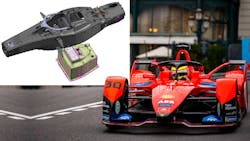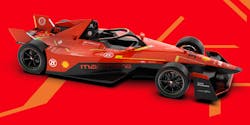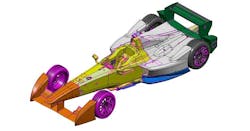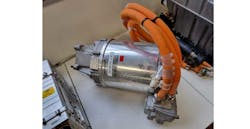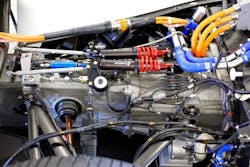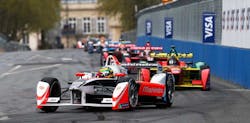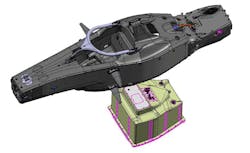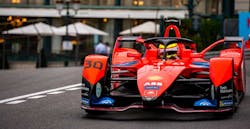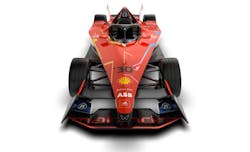In 2011, a handful European businessmen came up with the idea of starting a racing series modeled loosely on Formula 1 but for electric cars. By 2014, the ABB FIA Formula E World Championship, or Formula E, was up and running with 10 racing teams and holding its first race.
The goal of Formula E is to showcase exciting racing and make some money. But the series organizers also want to introduce new hybrid and electrical powerplants for cars, get automakers and suppliers working on new technologies for electric vehicles, and hopefully spread acceptance of e-vehicles and lower the carbon emissions coming from cars.
To keep the races competitive and prevent deep-pocket teams from dominating the racing season, those in charge of Formula E mandated that all teams use similar technology and the same major components (the “formula”). But advances in electric-vehicle technologies have comes so quickly that the series is now on its third generation of these mandates.
Here's a look at how the Formula E racecars have changed as they evolved through three generations of electric race cars (GEN 1, GEN 2 and GEN3).
GEN 1 (2014-2017)
The first-generation car, the Spark-Renault SRT 01E, was built by Spark Racing Technology out of parts and assemblies from a variety of top-notch automotive design companies.
The body, for example, was from Dallara, a successful Italian firm that engineers race cars for Indy, Formula 2 and 3, as well as LeMans.
The body and frame is a carbon-fiber monocoque design with Kevlar honeycomb reinforcements. A carbon/aluminum “tub” protects the driver in case of crashes. Fairings on the front cut wind resistance and fins along the side provided crash protection; they are not aerodynamic structures. There are, however, front and rear carbon-fiber wings for generating downforce that keeps the car firmly on the road.
Spark created the chassis, one based on a standard racing chassis but redesigned to house a battery pack rather than an engine.
Teams built their own rear suspensions. “It was mandated by regulation to be a conventional metallic wishbone architecture using a coil-over damper,” says Lewis Butler, technical director for Mahindra Racing, one of team competing in Formula E racing. “The wishbone suspension on every car ensures a relatively level playing field, and also ensures each car’s suspension can handle the bumpy streets that make up many of the racing circuits.”
The disk brakes used carbon fiber pads and there were two separate hydraulic subsystems operated by the same pedal. Calipers had to be made of aluminum.
18-in. low-profile Michelin tires front and back were treaded for wet and dry tracks. The tires were made in one compound, so there were no hard or soft tires like in Formula 1. One set of tires lasted the entire race. The tires also had a low-profile design which gave them less rolling resistance than the high-profile versions used on Formula 1 cars. Such energy-saving measures are critical in Formula E where power is limited.
The battery pack, built by Williams Advanced Engineering, used lithium-ion pouch cells and weighed about 550 lb, according to Butler. It was said to have the storage capacity of about 300 laptop batteries or 4,000 mobile-phone batteries. To keep the battery pack cool, dielectric fluid circulated through the pack to remove heat. “And they have tested safety features that ensure that if the battery pack gets punctured or has thermal issues, it would not lead to runaways and fires.””
“The battery had a decent usable capacity and was a good overall compromise between life constraints, power and energy content,” says Butler. “But technology has moved on significantly since then.”
The battery output, and therefore the car’s speed, was controlled so that it was limited to 200 kW (268 hp) during qualifying runs and to 180 kW (240 hp) when racing.
“This was done through battery-controlling software that is activated using steering wheel switches,” explains Butler. “This let the driver change the limits from the cockpit.”
That GEN 1 battery was also limited in that it could only store 28 kWh of energy, just enough to finish half a race. That is why each team needed two cars per driver; halfway through the race, the driver pit stopped and jumped into the fully charged car to complete the race.
In the first season, the GEN 1 car was powered by an electric motor developed by McLaren Applied Technology, the same as that used in its P1 supercar. That motor had magnets in the rotors and coils of copper wiring in the stator.
But since the second season, Formula E racing teams could build their own electric motor, inverter, gearbox and cooling subsystems. Still, putting a motor on each wheel to get the best torque distribution was forbidden. Nine teams designed and built powertrains for the 2016-2017 season, including Mahindra.
For the first season, all the teams used a five-speed gearbox made by Hewland Engineering to cut cost. It used paddle shifters mounted on the steering wheels.
In the second season, however, most teams built their own gearboxes, and by the fourth season all had opted for single-geared designs.
“The single-gear approach was possible, thanks to advances in the motor’s power density and increases in efficiency that came from engineers reducing transmission losses at high speeds,” says Butler.
“The move away from multi-geared transmission was also a way to prevent the use of ‘zero shift’ technology used in Formula 1 and other ‘paddle shift’ cars. It lets drivers pre-engage the target gear before disengaging from the previous one,” he explains.
GEN I cars typically were able to go from 0 to 62 mph in 3 sec. and had a top speed of 140 mph.
GEN I cars also had regenerative braking, which the driver could control when it was used and how much was applied. It slowed the cars down and turned the drive motor, which are actually called motor generator units (MGUs), to generate electricity and send it back into the battery for later use. Drivers that used the regen brakes to harvest energy most efficiently could drive the fastest for longest.
Other race-winning advantages were accomplished by using just the right suspension and wing adjustments for each race course and other energy-saving strategies, rather than developing better powertrains.
GEN 2 (2018-2021)
The second-generation Formula E car was introduced in the 2018-2019 season and featured significant technological advances over the previous car.
The most important change was the adaption of a new battery that could store 52 kWh of power. “The battery pack was improved by using newer cylindrical cells and higher voltages for less losses during races. The cooling was also improved,” says Butler.
The nearly doubling of the energy storage let teams complete races using only one car. The new battery also gave the cars more power, 250 kW. This translated into top speeds of 174 mph.
Contributing to the bump in speed was that the cars were lighter. “Materials used everywhere in the car were of higher quality or delivered more performance per unit mass, whether that was power electronics, casings, transmission parts, motor or cooling,” explains Butler. “Everything was reworked from the ground-up.”
For safety the league mandated the installation and use of halos. It’s a titanium rollbar of sorts that surrounds the top of the cockpit. If the car rolls over, it can withstand 12 tons of force and protect the driver from large flying objects such as wheels. Similar devices have been used on Indy cars since 2020.
Teams also added an aerodynamically sculpted diffuser panel that goes on the belly of the car. It adds enough downforce or grip for handling that teams could shrink the rear wing into a lighter X-wing design that most observers think gives the cars more visual pizazz. Front fenders were also added to enclose the front wheels to reduce turbulence and route it down the side of the car.
Though there was a mandated suspension upfront, teams could fit adjustable springs and dampers to handle the street circuits. At the rear, teams like Mahindra choose suspensions with wishbones, rockers, and spring/dampers that worked well with the position and weight of the powerplant
The front wheels were allowed to have approved air ducts for cooling the new Brembo brakes used on the cars. “It depends on the race circuit as to whether we use the ducts or not,” says Butler. “Typically, front brake temperatures do not get high enough to require them.”
To inject some tactical finesse into the races, the organizers added an attack mode to the driver’s controls. When the driver could activate it, it bumped up the power by 30 kW (40 hp), enough to overtake cars and make some quick passes.
There are two ways driver can “earn” attack mode capability. If the driver steers the car over activation lanes on the track which are painted with yellow and black arrows, sensors buried in the track register the move and an FIA controller wirelessly unlocks the capability in that car. Drivers can then use the boost of speed to make some serious moves over the next few laps. And they will need to because driving over the activation lanes requires leaving the best and fastest line through the course and losing seconds to the competitors. A driver can also gain access to the attack mode through fan-based voting (fanboost); the top vote getter earns an extra boost.
The number and duration of the attack mode are decided by the FIA an hour before the race, meaning the teams only have 60 min. to decide on a gameplan for the race.
To keep fans apprised, the halo protection device has an LED embedded in it that changes color. If it glows blue, the car is in attack mode; if it glows magenta, the driver has activated fanboost.
“Mahindra moved strongly into the Gen2 era with an all-new powertrain kit, as dictated by the regulations, and started strongly,” says Butler. “As is now nearly ubiquitous in Formula E cars, we continued using a transverse motor and reduction gearbox with no change gears. Now into the fourth and final season of GEN 2, we can still regularly make a strong showing despite the increasing strength of the opposition.”
GEN 3 (2022-?)
GEN 3 was rolled out this year and it has a more powerful motor and a redesigned chassis to accommodate that motor. The car, which now weighs 1,940 lb, were made lighter by about 155 lb. Most of this weight was cut from the redesigned battery pack, but the cars are also shorter and narrower with a look inspired by the aero-efficient delta wings of fighter jets. The chassis designers also had to do some innovative engineering work to maintain and improve driver safety in the lighter car.
There’s now no rear wing and the front wing was simplified so that drivers cannot use it to bump and damage other cars without damaging their own.
The rate at which energy can be recovered under regenerative braking has jumped, however, from 250 kW to 600 kW.
Mahindra Racing’s M9Electro for its GEN 3 car represents a revolutionary step compared with its GEN2 efforts.
Motors
- Transverse mounted ZF Race Rear MGU.
- Peak rpm increased to about 4,000 compared to the M8Electro.
- Motor delivers up to 350kw of power (470 hp), giving the car a top speed of 200 mph and a power-to-weight-ratio twice as high as an equivalent 470 hp internal combustion engine.
- Front MGU now required as part of the regeneration system.
Inverter
- Two inverters, each controlling their own MGU. Two inverters were needed to accommodate the front and rear MGU powertrains. The new front powertrain adds 250 kW to the rear’s 350 kW, more than doubling the regenerative capability of the GEN 2 to a total of 600 kW.
Cooling
- Parallel closed systems for inverters and motor with custom ducting and radiators.
Battery
- 600 kW peak regenerative power. At least 40% of the energy used during a race will be generated by regenerative braking. It's the first formula car that will not have rear hydraulic brakes due to the addition of the front powertrain and its regenerative/stopping capabilities.
- 300 kW power in race mode; 350 kW in qualifying mode.
- Liquid cooled.
- Designed to handle “flash-charging” at rates of up to 800 kW, allowing pitstop-recharging to Formula E racing.
Transmission
- Custom transmission from ZF Race with a single reduction ratio and an adjustable limited slip differential.
- Transverse layout.
- Custom Mahindra carbon fiber casing.
Rear suspension
- Custom lightweight, unequal-length wishbones with low friction bearings.
- Pushrod-actuated coil over dampers, with custom rockers and anti-roll bars.
- All-weather tires from Hankook will incorporate biomaterials and sustainable rubber.
What the GEN 4 racers will look like and what new technologies they will carry is currently being discussed. But cost will likely be an issue.
“Currently, only the tires are new for each race, everything else is typically engineered to last at least a season,” says Butler. And nothing beyond ancillary and commercial-off-the-shelf parts are used from one generation to the next. So yes, it is expensive, but hard to avoid when racing technology moves at least as fast if not even faster than the general marketplace. One generation (4 years) is now a long time in automotive technology.
